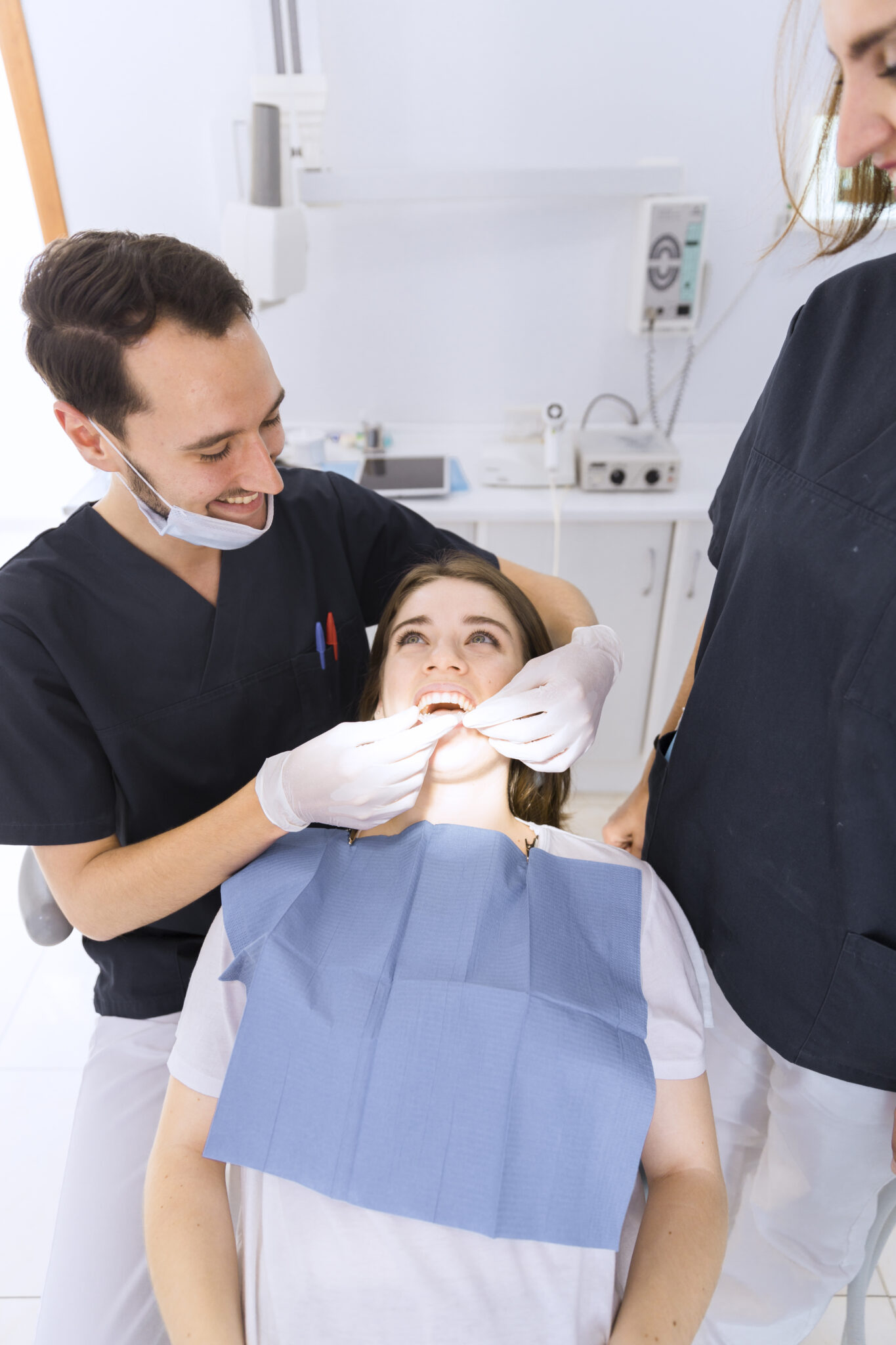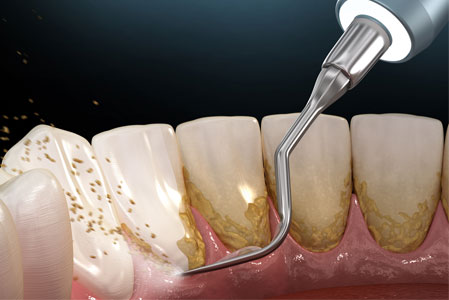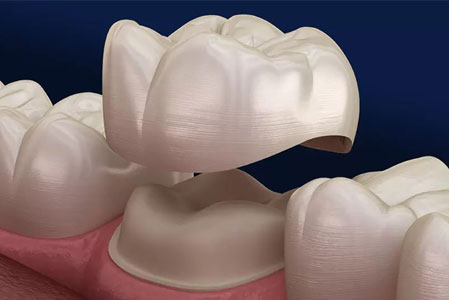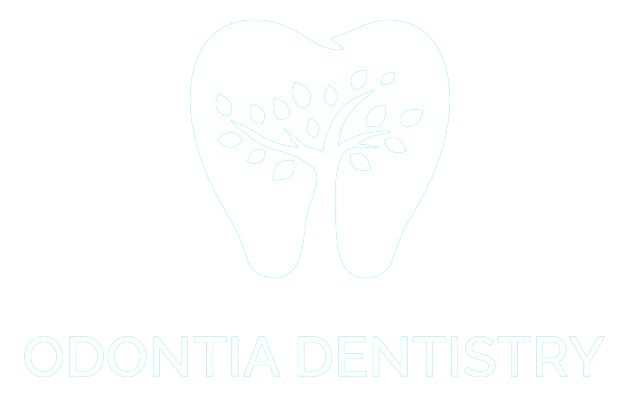Odontia Dentistry – where dental care meets excellence!

At Odontia Dentistry, we strongly believe that prevention is better than treatment. This is why we work with all our patients to build a customized program that will not only prevent teeth and gum diseases but also help maintain beautiful and strong teeth. Regular prevention will help teeth stay healthy and prevent you from spending heavily on treatments to remove decay, restore teeth and gums. This is why we always recommend a bi-annual visit to the dentist to just check if things are in order.Our Preventive dentistry involves the prevention of decay and gum diseases by certain precautionary procedures. These procedures include:
Root Canal Treatments:
The root canal treatment is a procedure where the dead pulp is taken out from the tooth and instead replaced with an inert material. The dental pulp, located in the centre of the tooth, can get affected by disease, injury, a deep cavity or a fracture. This results in exposure to bacteria and the pulp eventually gets infected and dies. Result? Extreme pain and sensitivity which can only be treated with an endodontic treatment like root canal. The treatment needs a steady hand and should only be performed by a trained endodontist. At Odontia, we combine both skill and technology to perform precise and almost painless root canal procedures. The inflamed pulp is removed by the in-house endodontist who cleans shapes and sterilizes the area besides filling the empty cavity with an inert dental sealer to avoid further infection.

Process of doing a root canal treatment involves:
The procedure is usually completed within a single appointment if the core (pulp) of the tooth is not inflamed or infected. The treatment may take multiple appointments (3-4 sessions, rarely more) depending on the extent of inflammation and infection.The preparation for and cementing of crowns require separate appointments.
A Crown is almost always recommended following root canal treatment. .A lot of tooth structure is lost already due to decay and trauma thus making the tooth dehydrated and brittle following root canal treatment. This makes it susceptible to fracture if there is no crown protecting it. Root canal treatment saves the tooth from extraction, but a crown restores the tooth to original form and function. Some of the indications that you need a root canal treatment are :
Apart from these natural causes, sometimes Root Canals are done intentionally to facilitate tooth preparation for aesthetic crowns and bridges

Dental bridges are fixed artificial teeth that “bridge” the gap between two existing natural teeth by anchoring on them. Dental bridges can be made of resins, metal alloys, ceramic fused to metal or all- ceramic. The choice of material for bridges depend on the size and condition of remaining natural teeth, amount of space available, aesthetic requirement or demand for the particular case and expected longevity of the bridge. At Odontia, our doctors will work with you to select the best option from a wide variety of solutions available.
Process of making a dental bridge:
Depending on the type of bridge and number of teeth, a time period of 4-7 days is to be expected between the two appointments. Complicated cases may require more days. However, rush service can be provided in certain cases on request.
Dental bridges can be made of any of the following materials
The choice of crowns depends on the individual case and on the aesthetic need of the patient.
Dental bridges can be made of any of the following materials
The choice of crowns depends on the individual case and on the aesthetic need of the patient.
Missing a tooth? Don’t worry, Dental Implants are here. Now your options are not limited to just dental bridges but very realistic looking implants that are coloured matched to your natural tooth colour. With the new range of implants that are available at Odontia, your friends and family would never be able to find the difference between your actual teeth and your implants!
The dental implants are artificial substitutes for natural tooth roots which are placed inside the jaw bone structure. They are usually made of titanium, which is highly biocompatible and well accepted by the body. Dental implants can be used to replace single or multiple teeth, full mouth rehabilitation and also help support and retain dentures.
Procedure for dental implants

Benefits of dental implants
Dentures: Dentures give you the confidence to laugh again. To eat without fear of embarrassment in public. Why they even make you look decades younger! Dentures are artificial devices that are placed in the mouth to replace missing tooth or teeth and are removable by the patient for cleaning and hygiene purposes. They can be made of metal or more commonly plastic (acrylic). Partial dentures replace one tooth or a few teeth and complete dentures replace all the teeth in a particular arch.
No. Dentures are removable by the patient and must be removed at least two times a day for cleaning.
Partial dentures may take some support from teeth with the help of metal wires. Most of the support for dentures is taken from the gums and palate with the help of metal or plastic plate. Complete dentures take all their support from gums.
Dental bridges can be made of any of the following materials
The choice of crowns depends on the individual case and on the aesthetic need of the patient.
Dentures should be changed when:
Restores esthetics, smile and confidence to patients who have lost teeth, Improves eating capacity, speech

Braces and orthodontic treatment:
Orthodontics specializes in the diagnosis, prevention and correction of dentofacial irregularities such as crowded teeth, forwardly placed teeth and abnormal position of the teeth and the jaws. While most individuals are treated with orthodontic braces in their teens, we at Odontia Dentistry believe that the best time to start consulting a dentist is when the child is about six years of age. Through early detection and correction, we are able to avoid major orthodontic work in later years by using space maintaining devices to avoid overcrowding of teeth.
Orthodontic treatment improves any discrepancies in the position of the jaw or its size, besides the fact that a good and regular set of teeth helps in a person looking good, feeling good, for audible and coherent speech with the most important point of chewing food in a proper manner.
Modern technology has created a lot of advances in the field of dentistry. One such revolutionary step is the invasalign clear orthodontic braces. Apart from the regular metallic braces, at Odontia we work a lot with ceramic braces. These are less noticeable and is definitely a more aesthetic option as compared to the metallic braces.
Orthodontic treatment for adults is gaining popularity worldwide and we have patients well into adulthood opting for treatments to correct their teeth alignment. The doctors at Odontia Dentistry will work with you to give you that beautiful smile which makes you look young and attractive.
Indications for orthodontic treatment
It is generally recommended that a child has an orthodontic consultation at age of 6. This helps in intercepting, anticipating and planning treatment for later. The braces are usually started between 11-13 years of age when all or most of the permanent teeth have erupted. However braces can be done at any age. There is no age limit for having orthodontic treatment provided the gums are strong.
The orthodontic treatment would vary depending on the procedure required for the jaws or the teeth or both. With the advance of technology and years of experience, the orthodontist would use the necessary procedures such as fixed braces which would require a time period of 1-2 years where all the permanent teeth have grown with very little discrepancy of the jaw. It takes three to four years to correct jaw discrepancies in children who are growing.
There are different types of braces used depending on the individual case. The most commonly used braces are made of metal. For individuals who are conscious of braces, several less conspicuous options like ceramic braces, lingual orthodontic braces and invisalign are available. In lingual orthodontics, the braces are fixed on the inner aspect of the teeth and therefore not very conspicuous. Invisalign are transparent, invisible braces which are aesthetically appealing.
Retainers are usually removable appliances given after the completion of braces treatment. The purpose of retainers is to stabilize the teeth in their newly aligned positions. Retainers are to be used as directed and are to be discontinued only after clearance from the orthodontist.
In some cases, there can be a large discrepancy between jaws that cannot be corrected by wearing braces alone. Additionally, jaw corrective surgery may be required along with braces to correct the discrepancy and produce an aesthetically and functionally acceptable result. In such cases, the planning for surgery is done at the start of the orthodontic treatment itself. Typically, the patient wears braces for a period of 1-2 years followed by surgery and continues with the braces for 6-8 months after surgery to achieve the optimal result.
We all love to look and feel beautiful. Cosmetic dentistry is both a science and an art that helps create and maintain not just healthy but also beautiful teeth.
Multiple factors define our smile – the shape of our jaw, size and shape of our teeth, its alignment, colour etc. We at Odontia Dentistry bring together a variety of specialists like orthodontists, prosthodontists, endodontists to give you that picture perfect smile.
Procedures in aesthetic treatment
If you want to get your smile aesthetically corrected, you will be examined thoroughly and assessed with the help of photographs, study models and x-rays.

Your expectations are determined and the mock wax-up is performed in the models to envision the probable outcome of treatment. Once we agree on the aesthetic result, the treatment options are discussed. One or more of the following procedures may be performed depending on the individuals requirement
Smile Design:
Smile is an important aspect of a person’s personality and an attractive smile can give you the self-confidence to succeed personally and professionally. We at Odontia Dentistry help enhance your smile through certain aesthetic dental procedures making it more attractive and pleasing. Individuals who are unhappy with their smile, those who refrain from smiling as they are conscious of their teeth, individuals who are always in the limelight, brides/grooms and those who desire make their smile more attractive are candidates for aesthetic treatment.
We can help aesthetically correct:
It is difficult to predict for how long the teeth whitening lasts. Whitening usually lasts for about 6 months to 1 year. It can last longer if smoking and food with colorants can be minimized or avoided. It also varies from person to person with whitening lasting longer in some more than others.
The whitening process can whiten only the enamel of the tooth. Crowns and bridges cannot be whitened. Therefore, whitening the teeth other than crowns will make the crowns stand out and the aesthetic appeal is lost. Also individuals with very sensitive teeth and multiple fillings in their teeth are not good candidates as it can worsen the sensitivity or isolate the fillings. We will be able to examine and tell you if you are a right candidate for teeth whitening and also what type of whitening is suitable for you.
Veneers are thin, strong and aesthetic porcelain laminates that are attached to or bonded on teeth to improve their appearance. Veneers can mask discoloration, bridge gaps between teeth and alter shape and size of teeth to achieve desired aesthetics.
Your teeth can get discolored due to aging, bad food habits, smoking and aerated beverages. This ends up making them look unattractive and dull. The Teeth whitening treatment at Odontia Dentistry helps restore the colour of the teeth and enhances your smile by making your teeth whiter.
Teeth whitening involve the use of specialized whitening powders/ gels to whiten teeth with the help LED light or lasers to activate them to get the best results. This method can take about 45 minutes to an hour and may require one or two sittings. The result – Beautiful, pearly white teeth.
